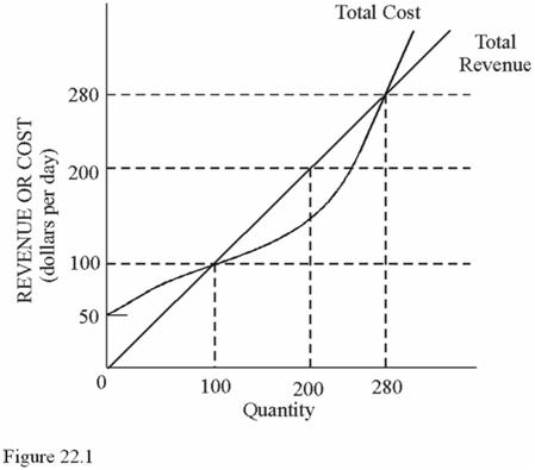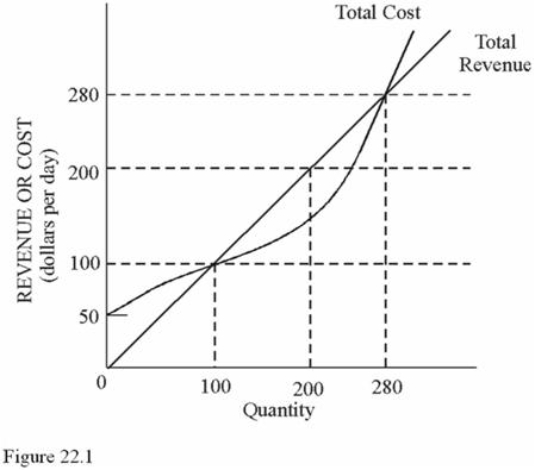A) Greater than accounting profit by the amount of implicit cost.
B) Greater than accounting profit by the amount of explicit cost.
C) Less than accounting profit by the amount of implicit cost.
D) Less than accounting profit by the amount of explicit cost.
Correct Answer

verified
Correct Answer
verified
Multiple Choice
Suppose a firm has an annual budget of $200,000 in wages and salaries, $75,000 in materials, $30,000 in new equipment, $20,000 in rented property, and $35,000 in interest costs on capital.The owner/manager does not choose to pay himself, but he could receive income of $90,000 by working elsewhere.The firm earns revenues of $360,000 per year. What is the economic profit for the firm described above?
A) -$90,000.
B) $0.
C) $90,000.
D) $200,000.
Correct Answer

verified
Correct Answer
verified
Multiple Choice
The short run is the time period
A) Over which an investment decision can be made.
B) Necessary so that profits can be earned from production.
C) In which some costs are fixed.
D) In which only the amount of capital may be altered.
Correct Answer

verified
Correct Answer
verified
Multiple Choice
 Refer to the data in Figure 22.1.The shape of the total revenue curve indicates that the price of this good
Refer to the data in Figure 22.1.The shape of the total revenue curve indicates that the price of this good
A) Falls as output rises.
B) Rises as output rises.
C) Stays the same as output rises.
D) Falls at first as output rises, but then rises as output rises.
Correct Answer

verified
Correct Answer
verified
Multiple Choice
 Refer to the data in Figure 22.1.The total fixed costs for this firm are approximately
Refer to the data in Figure 22.1.The total fixed costs for this firm are approximately
A) $50.
B) $100.
C) $600.
D) $200.
Correct Answer

verified
Correct Answer
verified
Multiple Choice
All of the following are ways a business can earn economic profits except
A) Discover new products.
B) Maximize implicit costs but not explicit costs.
C) Take above-average risks.
D) Find new and better methods of production.
Correct Answer

verified
Correct Answer
verified
Multiple Choice
 Refer to the data in Figure 22.1.The price of this good
Refer to the data in Figure 22.1.The price of this good
A) Is $50 per unit.
B) Is $1 per unit.
C) Is $100 per unit.
D) Varies as output changes.
Correct Answer

verified
Correct Answer
verified
True/False
Normal profit is zero when a firm's revenues just cover its economic cost.
Correct Answer

verified
Correct Answer
verified
True/False
For perfectly competitive firms, marginal revenue always equals price.
Correct Answer

verified
Correct Answer
verified
Multiple Choice
A firm experiencing economic losses will still continue to produce output in the short run as long as
A) Revenues are greater than total fixed cost.
B) MR = MC.
C) Price is above average variable cost.
D) Price is above average fixed cost.
Correct Answer

verified
Correct Answer
verified
Multiple Choice
Accounting costs and economic costs differ because
A) Accounting costs exceed economic costs whenever any factor is not paid an explicit wage.
B) Accounting costs include implicit costs, and economic costs do not.
C) Economic costs include the opportunity costs of all resources used, while accounting costs include actual dollar outlays.
D) Accounting costs include explicit costs, and economic costs do not.
Correct Answer

verified
Correct Answer
verified
Multiple Choice
The difference between the total revenue and total cost curves at a given output is equal to
A) Total profit.
B) Profit per unit.
C) Average revenue.
D) Average total cost.
Correct Answer

verified
Correct Answer
verified
Multiple Choice
Businesses that fail to account for implicit costs, like the strawberry farmer, Hiroshi Fujishige, who failed to consider the enormous opportunity of selling his property to Disneyland, will
A) Go out of business immediately.
B) Make higher-than-normal profits.
C) Make more money when they shut down.
D) Have to increase revenues in order to stay in business.
Correct Answer

verified
Correct Answer
verified
True/False
In the short run, a firm will maximize profits if it increases output when marginal revenue is greater than marginal cost.
Correct Answer

verified
Correct Answer
verified
Multiple Choice
Which of the following is generally a fixed cost?
A) Property taxes on land used in production.
B) Wages.
C) Profit taxes.
D) Utilities.
Correct Answer

verified
Correct Answer
verified
Multiple Choice
When a firm minimizes its losses in the short run,
A) It continues to produce only if price exceeds average variable cost.
B) The firm makes an investment decision.
C) The firm enters or exits from the market.
D) It continues to produce only if price exceeds marginal revenue.
Correct Answer

verified
Correct Answer
verified
Multiple Choice
A competitive firm should always continue to operate in the short run as long as
A) P < ATC.
B) P < AVC.
C) MR > AVC.
D) MR > MC.
Correct Answer

verified
Correct Answer
verified
Multiple Choice
The long run is
A) A period longer than one year.
B) The period required to produce a unit of the firm's output.
C) A period long enough for all inputs to be variable.
D) Approximately one year.
Correct Answer

verified
Correct Answer
verified
Multiple Choice
The supply curve is upward-sloping (i.e., it takes a higher price to induce greater production) because of
A) Increasing total costs.
B) Increasing fixed costs.
C) Increasing marginal costs.
D) The decreasing skill level of additional workers.
Correct Answer

verified
Correct Answer
verified
True/False
Maximizing revenue maximizes profits.
Correct Answer

verified
Correct Answer
verified
Showing 121 - 140 of 149
Related Exams